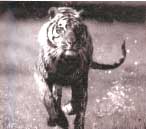Problem pugmarks
 THE methodology used in conducting tiger count in several sanctuaries and national parks in India has currently come under focus and has given rise to a stormy debate. The focus has shifted from how many tigers are there in the country to what method should be adopted to count the animal's population. At present the census is taken by examining pugmarks, which is increasingly being held by many as 'inaccurate and cumber some' as it is subject to human error.
THE methodology used in conducting tiger count in several sanctuaries and national parks in India has currently come under focus and has given rise to a stormy debate. The focus has shifted from how many tigers are there in the country to what method should be adopted to count the animal's population. At present the census is taken by examining pugmarks, which is increasingly being held by many as 'inaccurate and cumber some' as it is subject to human error.
"in the present circumstances, it is the best alternative. After all, the tiger is a shy and nocturnal animal, and one cannot just walk up to it and take its details," says the director of Corbett Tiger Reserve, R C Gautam. The method entails lifting tiger pugmark impressions along water courses and jungle paths. As every tiger has its distinctive pugmark, on examination, the impressions give a fair idea of the number of tigers that are present in the particular sanctuary. The 1993 census which was compiled after adopting such a method, put the tiger population of the country at more than 3,750.
Usually, pugmarks are traced during the dry season as rain does not wash them away. In places where there is no surface on which clear impressions may be obtained, special pug pads are laid, said R Talwar of the World Wide Fund for Nature-India.
